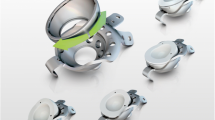Abstract
Background
The saddle prosthesis originally was developed to reconstruct large acetabular defects in revision hip arthroplasty and was used primarily for hip reconstruction after periacetabular tumor resections. The long-term survival of these reconstructions is unclear.
Questions/purpose
We therefore examined the long-term function, complications, and survival in patients treated with saddle prostheses after periacetabular tumor resection.
Patients and Methods
Between 1987 and 2003 we treated 17 patients with a saddle prosthesis after periacetabular tumor resection (12 chondrosarcomas, three osteosarcomas, one malignant fibrous histiocytoma, one metastasis). During followup, 11 patients died, resulting in a median overall survival of 49 months (95% CI, 30–68 months). The remaining six patients were alive without disease (mean followup, 12.1 years; range, 8.3–16.8 years). In one patient the saddle prosthesis was removed after 3 months owing to dislocation and infection. We obtained SF-36 questionnaires, Toronto Extremity Salvage Scores (TESS), and Musculoskeletal Tumor Society (MSTS) scores.
Results
Thirteen of 17 patients used walking assists for mobilization at last followup: eight patients required two crutches, five needed one crutch, and one did not use any walking aids. The other three patients were not able to mobilize independently and only made bed to chair transfers. The mean hip flexion in the six surviving patients was 60° (range, 40°–100°) at last followup. Local complications were seen in 14 of the 17 patients: nine wound infections, seven dislocations, and two leg-length discrepancies requiring additional surgery. In the five surviving patients with their index prosthesis still in situ, the mean MSTS score at long-term followup was 47% (range, 20%–77%), the mean TESS score was 53% (range, 41%–67%), and the mean composite SF-36 physical and mental component summaries were 43.9 and 50.6, respectively.
Conclusion
Reconstruction with saddle prostheses after periacetabular tumor surgery has a high risk of complications and poor long-term function with limited hip flexion; therefore, we no longer use the saddle prosthesis for reconstruction after periacetabular tumor resections.
Level of Evidence
Level IV, retrospective case series. See the Guideline for Authors for a complete description of levels of evidence.


Similar content being viewed by others
References
Aboulafia AJ, Buch R, Mathews J, Li W, Malawer MM. Reconstruction using saddle prosthesis following excision of primary and metastatic periacetabular tumors. Clin Orthop Relat Res. 1995;314:203–213.
Aljassir F, Beadel GP, Turcotte RE, Griffin AM, Bell RS, Wunder JS, Isler MH. Outcome after pelvic sarcoma resection reconstructed with saddle prosthesis. Clin Orthop Relat Res. 2005;438:36–41.
Apffelstaedt JP, Driscoll DL, Spellmann JE, Velez AF, Gibbs JF, Karakousis CP. Complications and outcome of external hemipelvectomy in the management of pelvic tumors. Ann Surg Oncol. 1996;3:304–309.
Beck LA, Einertson MJ, Winemiller MH, DePompolo RW, Hoppe KM, Sim FF. Functional outcomes and quality of life after tumor-related hemipelvectomy. Phys Ther. 2008;88:916–927.
Benevenia J, Cyran FP, Biermann JS, Patterson FR, Leeson MC. Treatment of advanced metastatic lesions of the acetabulum using the saddle prosthesis. Clin Orthop Relat Res. 2004;426:23–31.
Brazier JE, Harper R, Jones NM, O’Cathain A, Thomas KJ, Usherwood T, Westlake L. Validating the SF-36 health questionnaire: new outcome measure for primary care. BMJ. 1992;305:160–164.
Campanna R, van Horn JR, Guernelli N, Briccoli A, Ruggieri P, Biagini R, Bettelli G, Campanacci M. Complications of pelvic resections. Arch Orthop Trauma Surg. 1987;106:71–77.
Cottias P, Jeanrot C, Vinh TS, Tomeno B, Anract P. Complications and functional evaluation of 17 saddle prostheses for resection of periacetabular tumors. J Surg Oncol. 2001;78:90–100.
Davis AM, Bell RS, Badley EM, Yoshida K, Williams JI. Evaluating functional outcome in patients with lower extremity sarcoma. Clin Orthop Relat Res. 1999;358:90–100.
Deloin X, Dumaine V, Biau D, Karoubi M, Babinet A, Tomeno B, Anract P. Pelvic chondrosarcomas: surgical treatment options. Orthop Traumatol Surg Res. 2009;95:393–401.
Eilber FR, Grant TT, Sakai D, Morton DL. Internal hemipelvectomy: excision of the hemipelvis with limb preservation. An alternative to hemipelvectomy. Cancer. 1979;43:806–809.
Enneking WF, Dunham WK. Resection and reconstruction for primary neoplasms involving the innominate bone. J Bone Joint Surg Am. 1978;60:731–746.
Enneking WF, Dunham WK, Gebhart MC, Malawar M, Pritchard DJ. A system for the functional evaluation of reconstructive procedures after surgical treatment of tumors of the musculoskeletal system. Clin Orthop Relat Res.1993;286:241–246.
Enneking WF, Spanier SS, Goodman MA. A system for the surgical staging of musculoskeletal sarcoma. Clin Orthop Relat Res. 1980;153:106–120.
Falkinstein Y, Ahlmann ER, Menendez LR. Reconstruction of type II pelvic resection with a new peri-acetabular reconstruction endoprosthesis. J Bone Joint Surg Br. 2008;90:371–376.
Fuchs B, O’Connor MI, Kaufman KR, Padgett DJ, Sim FH. Iliofemoral arthrodesis and pseudarthrosis: a long-term functional outcome evaluation. Clin Orthop Relat Res. 2002;397:29–35.
Griesser MJ, Gillette B, Crist M, Pan X, Muscarella P, Scharschmidt T, Mayerson J. Internal and external hemipelvectomy or flail hip in patients with sarcomas: quality-of-life and functional outcomes. Am J Phys Med Rehabil. 2012;91:24–32.
Ham SJ, Schraffordt Koops H, Veth RP, van Horn JR, Eisma WH, Hoekstra HJ. External and internal hemipelvectomy for sarcomas of the pelvic girdle: consequences of limb salvage treatment. Eur J Surg Oncol. 1997;23:540–546.
Harrington KD. The use of hemipelvic allografts or autoclaved grafts for reconstruction after wide resections of malignant tumors of the pelvis. J Bone Joint Surg Am. 1992;74:331–341.
Kitagawa Y, Ek ET, Choong PF. Pelvic reconstruction using saddle prosthesis following limb salvage operation for periacetabular tumour. J Orthop Surg (Hong Kong). 2006;14:155–162.
Menendez LR, Ahlmann ER, Falkinstein Y, Allison DC. Periacetabular reconstruction with a new endoprosthesis. Clin Orthop Relat Res. 2009;467:2831–2837.
Murray TG, Wetters NG, Moric M, Sporer SM, Paprosky WG, Della Valle CJ. The use of abduction bracing for the prevention of early postoperative dislocation after revision total hip arthroplasty. J Arthroplasty. 2012:27(8 suppl);126–129.
Nieder E, Elson RA, Engelbrecht E, Kasselt MR, Kellar A, Steinbrink K. The saddle prosthesis for salvage of the destroyed acetabulum. J Bone Joint Surg Br. 1990;72:1014–1022.
Ozaki T, Hillmann A, Bettin D, Wuisman P, Winkelmann W. High complication rates with pelvic allografts: experience of 22 sarcoma resections. Acta Orthop Scand. 1996;67:333–338.
Renard AJ, Veth RP, Schreuder HW, Pruszczynski M, Keller A, van Hoesel Q, Bökkerink JP. The saddle prosthesis in pelvic primary and secondary musculoskeletal tumors: functional results at several postoperative intervals. Arch Orthop Trauma Surg. 2000;120:188–194.
Renard AJ, Veth RP, Schreuder HW, van Loon CJ, Koops HS, van Horn JR. Function and complications after ablative and limb salvage therapy in lower extremity sarcoma of bone. J Surg Oncol. 2000;73:198–205.
Schwartz AJ, Kiatisevi P, Eilber FC, Eilber FR, Eckardt JJ. The Freidman-Eilber resection arthroplasty of the pelvis. Clin Orthop Relat Res. 2009;467:2825–2830.
van der Lei B, Hoekstra HJ, Veth RP, Ham SJ, Oldhoff J, Schraffordt Koops H. The use of the saddle prosthesis for reconstruction of the hip joint after tumor resection of the pelvis. J Surg Oncol. 1992;50:216–219.
Windhager R, Karner J, Kutschera HP, Polterauer P, Salzer-Kuntschik M, Kotz R. Limb salvage in periacetabular sarcomas: review of 21 consecutive cases. Clin Orthop Relat Res. 1996;331:265–276.
Witte D, Bernd L, Bruns J, Gosheger G, Hardes J, Hartwig E, Lehner B, Melcher I, Mutschler W, Schulte M, Tunn PU, Wozniak W, Zahlten-Hinguranage A, Zeifang F. Limb-salvage reconstruction with MUTARS hemipelvic endoprosthesis: a prospective multicenter study. Eur J Surg Oncol. 2009;35:1318–1325.
Acknowledgments
We thank Vivian M. Spaans MD, for her contribution in computing implant survivorship and generating the Kaplan-Meier curve.
Author information
Authors and Affiliations
Corresponding author
Additional information
Each author certifies that he or she, or a member of their immediate family, has no commercial associations (eg, consultancies, stock ownership, equity interest, patent/licensing arrangements, etc) that might pose a conflict of interest in connection with the submitted article.
All ICMJE Conflict of Interest Forms for authors and Clinical Orthopaedics and Related Research editors and board members are on file with the publication and can be viewed on request.
Each author certifies that his or her institution approved the human protocol for this investigation, that all investigations were conducted in conformity with ethical principles of research, and that informed consent for participation in the study was obtained.
Clinical Orthopaedics and Related Research neither advocates nor endorses the use of any treatment, drug, or device. Readers are encouraged to always seek additional information, including FDA-approval status, of any drug or device prior to clinical use.
About this article
Cite this article
Jansen, J.A., van de Sande, M.A.J. & Dijkstra, P.D.S. Poor Long-term Clinical Results of Saddle Prosthesis After Resection of Periacetabular Tumors. Clin Orthop Relat Res 471, 324–331 (2013). https://doi.org/10.1007/s11999-012-2631-x
Received:
Accepted:
Published:
Issue Date:
DOI: https://doi.org/10.1007/s11999-012-2631-x




